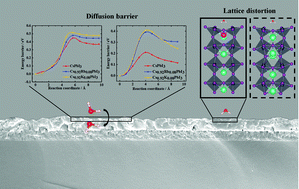Suppressed phase transition of a Rb/K incorporated inorganic perovskite with a water-repelling surface†
Abstract
Inorganic cesium lead halide (CsPbI3) is a promising candidate for next-generation photovoltaic devices, but photoactive α-phase CsPbI3 can rapidly transform to non-photoactive yellow δ-CsPbI3 in a humid atmosphere. Here, we report that partial substitution of cesium by the potassium or rubidium element can effectively improve the phase stability against moisture by forming a water-repelling surface layer with Rb/K segregation. Using density functional theory, we found that the water-induced polarization, which triggers the PbI62− octahedron distortion and accelerates the phase transition, can be effectively alleviated by incorporating Rb/K elements. Further exploration of transition states suggests that Rb/K doped surface layers result in a higher activation barrier for water penetration. The electronic structure analysis further reveals that the barrier enhancement originates from the absence of the participation of inner 5p electrons in Rb/K-H2O binding, which induces a much lower energy barrier in pristine CsPbI3. Based on these improvements, the doped perovskites remained in the major α-phase after direct exposure to ambient air (RH ∼ 30%) for 5 hours, while pristine CsPbI3 showed an irreversible degradation. With the clarified mechanism of enhanced phase stability of Rb/K incorporation, we suggest such a doping method as a promising strategy to be widely applied in the field of photovoltaic devices.

- This article is part of the themed collection: Research selection from the NCNST


 Please wait while we load your content...
Please wait while we load your content...